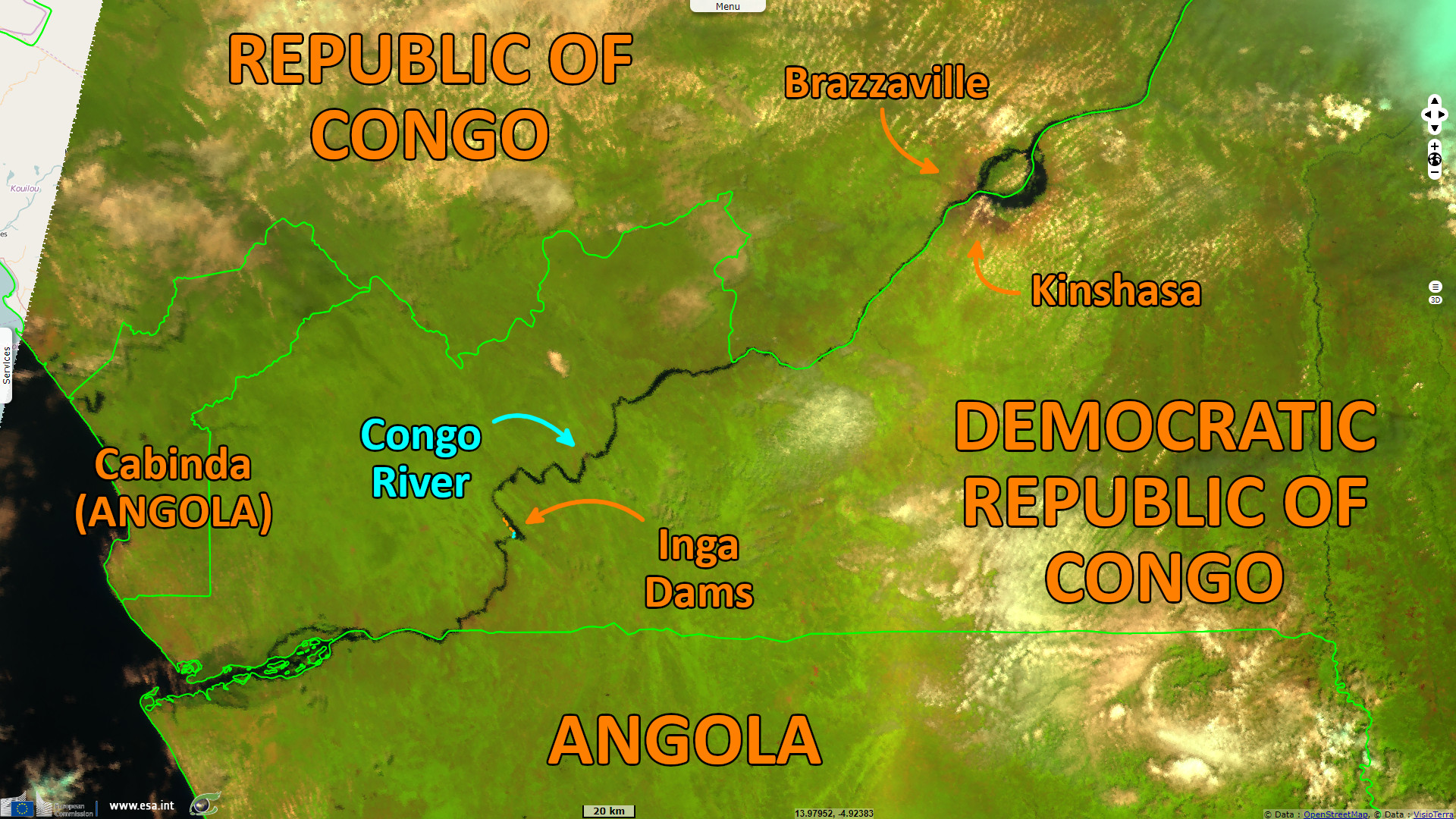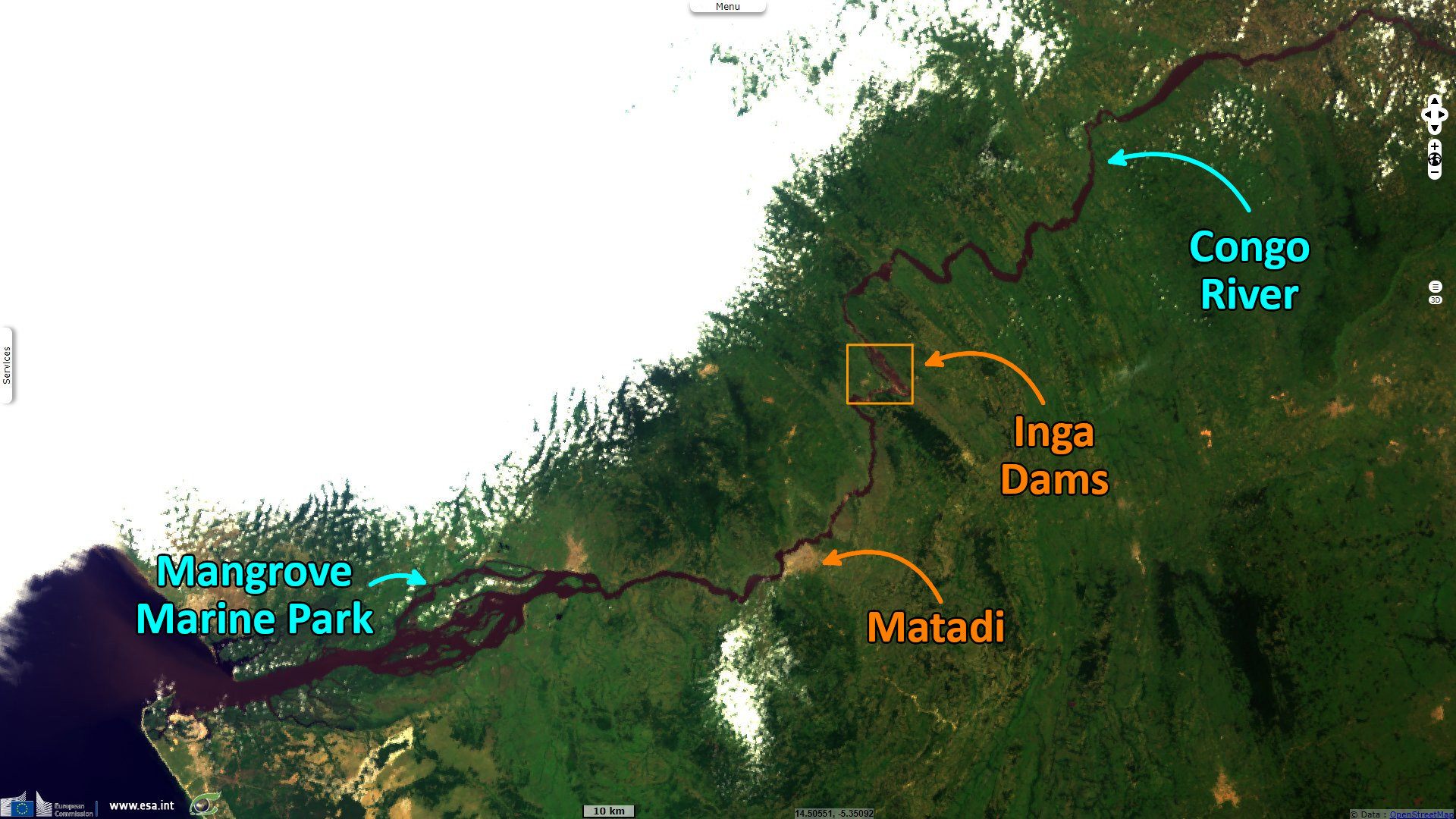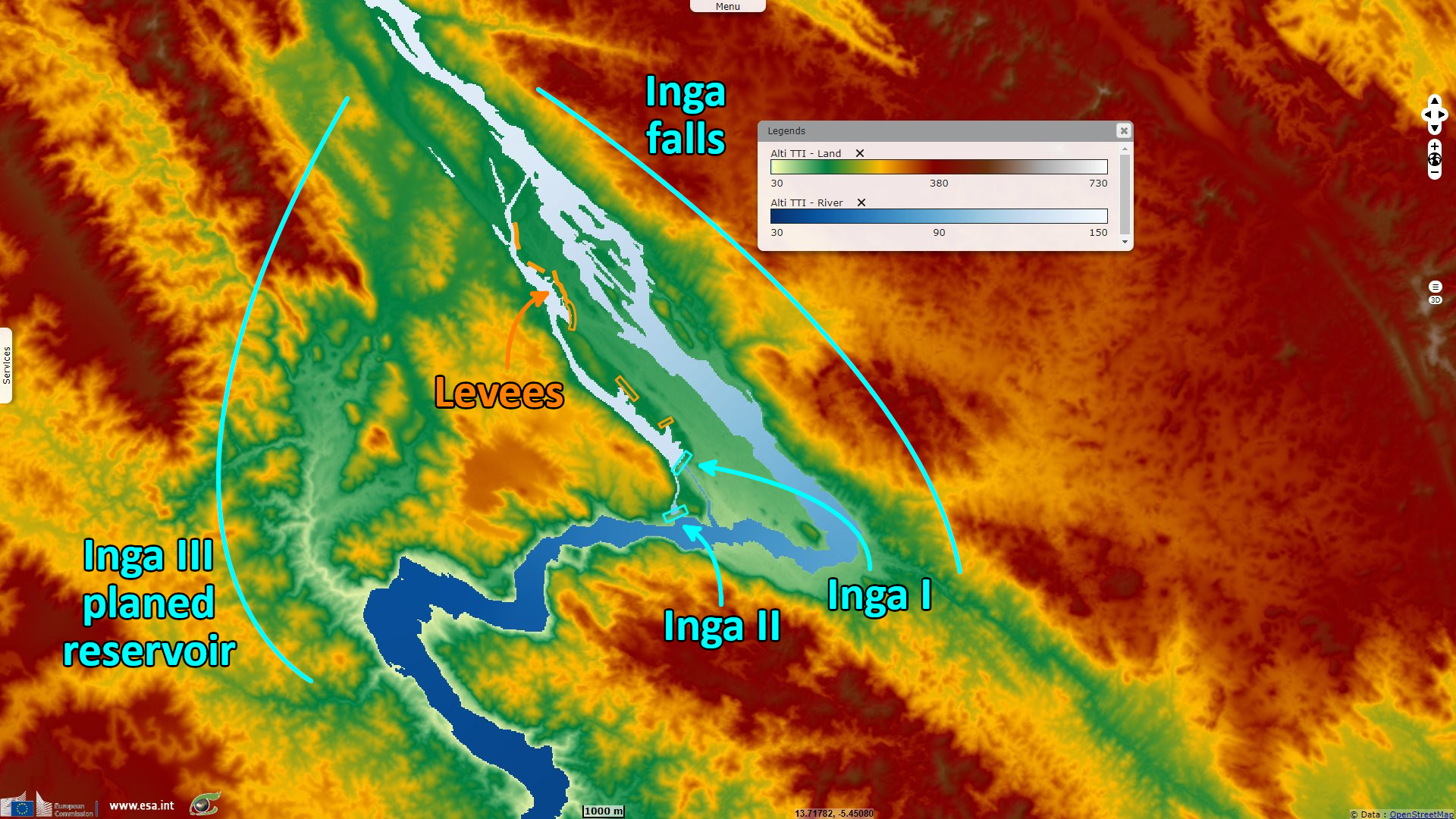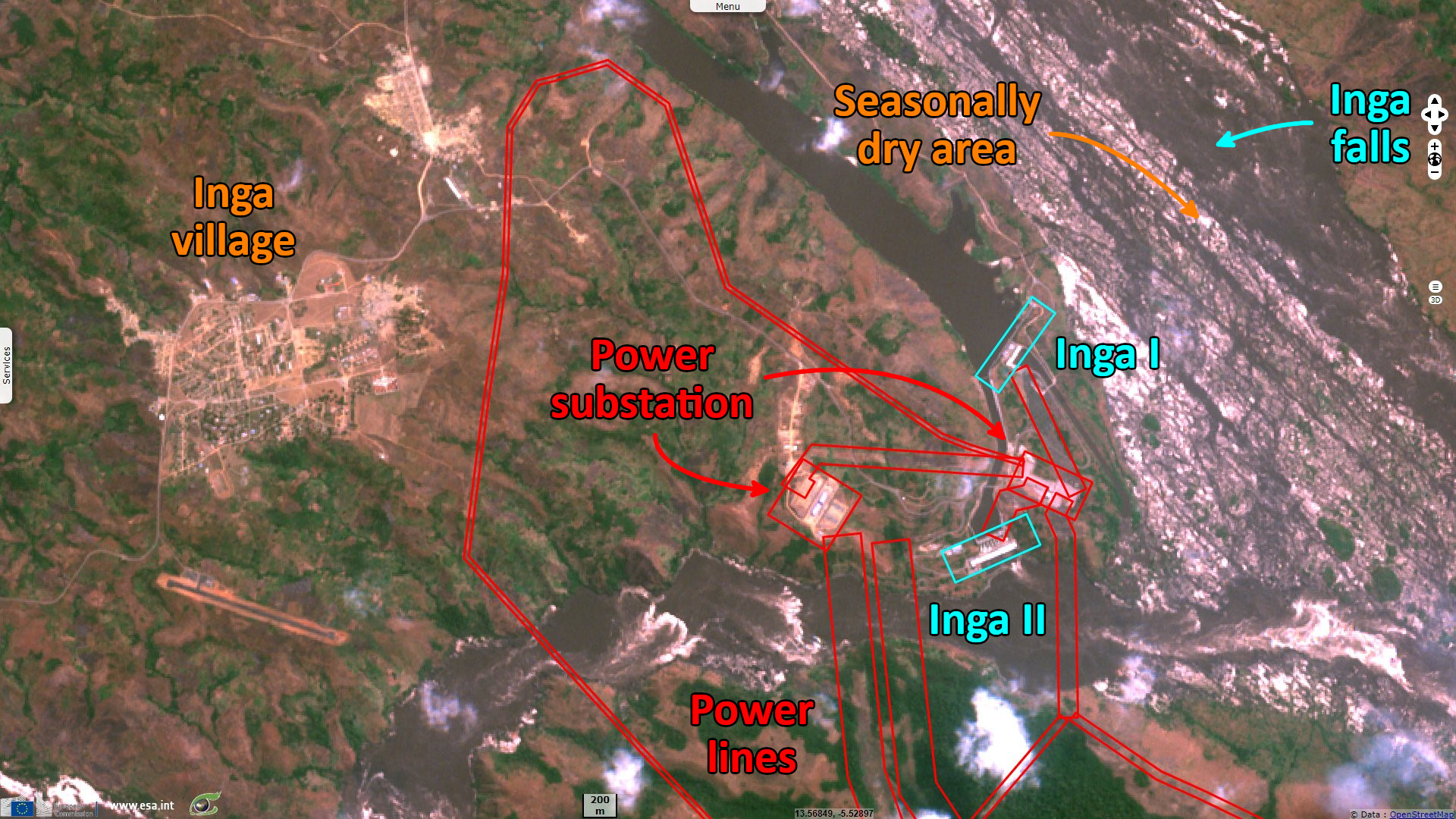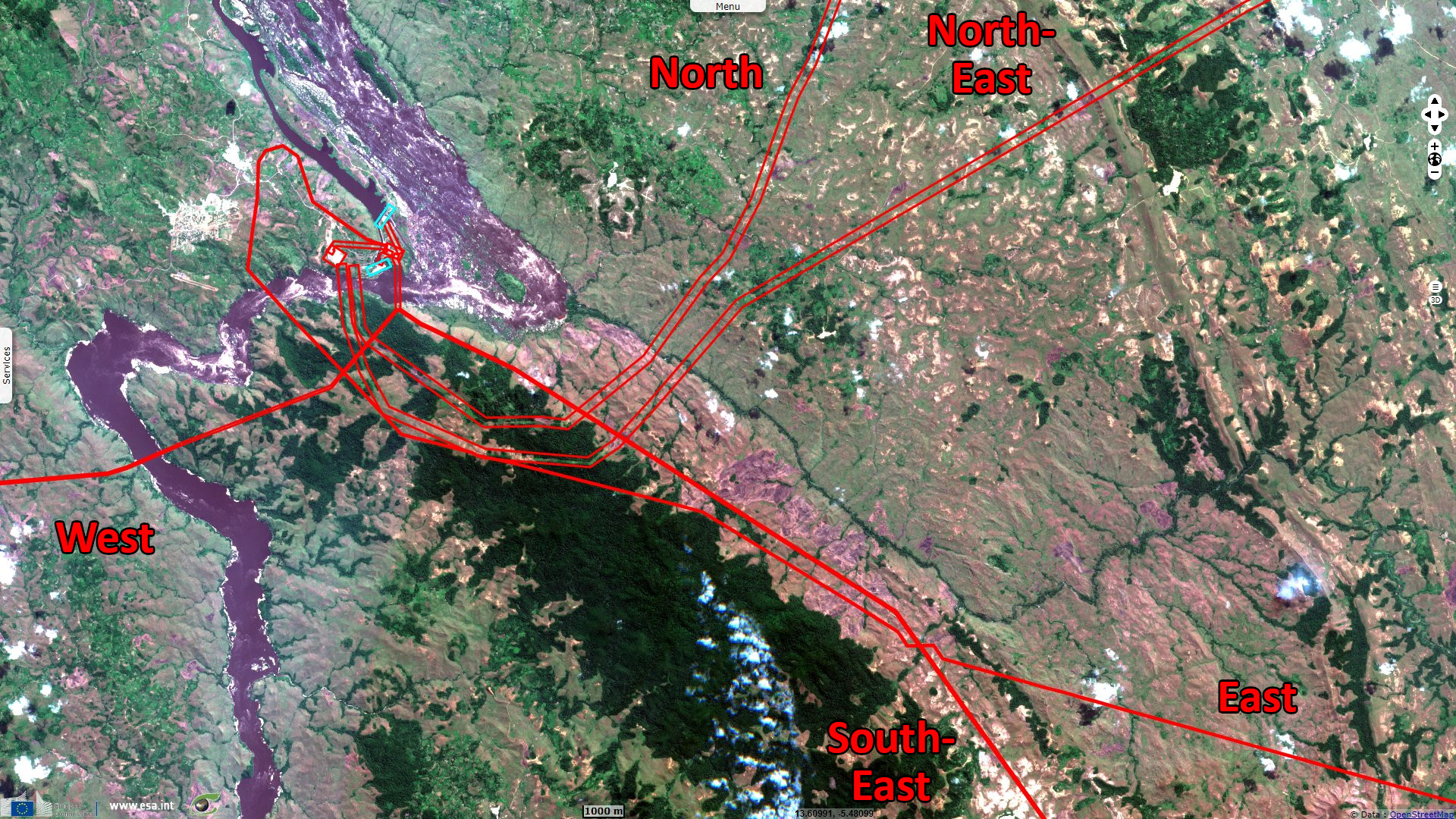Clouds on the Inga dams energy production, lower Congo, DRC
Sentinel-1 CSAR IW acquired on 02 August 2015 at 04:43:34 UTC
...
Sentinel-3 OLCI FR acquired on 09 June 2018 at 08:46:53 UTC
Sentinel-1 CSAR IW acquired on 17 January 2020 at 17:24:45 UTC
Sentinel-3 SLSTR RBT acquired on 21 January 2022 at 08:33:57 UTC
Sentinel-2 MSI acquired on 19 June 2022 at 09:06:11 UTC
Sentinel-2 MSI acquired on 03 August 2022 at 09:05:59 UTC
...
Sentinel-3 OLCI FR acquired on 09 June 2018 at 08:46:53 UTC
Sentinel-1 CSAR IW acquired on 17 January 2020 at 17:24:45 UTC
Sentinel-3 SLSTR RBT acquired on 21 January 2022 at 08:33:57 UTC
Sentinel-2 MSI acquired on 19 June 2022 at 09:06:11 UTC
Sentinel-2 MSI acquired on 03 August 2022 at 09:05:59 UTC
Keyword(s): Climate change, hydrology, hydropower, clean energies, dam, infrastructure, Congo river, DRC
Inga Falls on the Congo River is a group of rapids 40 km from Matadi downstream in the Democratic Republic of the Congo. The Congo River drops 96 m over the course of 15 km within this set of cataracts. The falls are part of a larger group of rapids in the lower Congo River. Livingstone Falls are located upstream closer to the Pool Malebo. These falls have formed in a sharp bend of Congo River where the width of river fluctuates from more than 4 km to only 260 m.
The Grand Inga project was conceived in the 1960s to exploit the Congo River, whose waters are the deepest in the world. Inga Falls is currently the site of two large hydro power plants opened in 1972 and 1982. The DRC has faced the problem of rehabilitating these two existing dams, which have fallen into disrepair and operate far below original capacity at roughly 40%, or just over 700 MW combined. Power lines also face problem of lack of maintenance.
Tranches I and II continue to operate at sub-optimal levels due to poor governance and inadequate infrastructure maintenance, the leaders of southern Africa have nonetheless lobbied in favour of a new Pharaonic project.
The mean annual flow rate of the Congo River at Inga Falls is ~42 000 m3/s. Given this flow rate and the 96-metre fall, the Inga Falls alone has a potential to generate ~39.6 GW of mechanical energy and nearly as much electrical energy. That is twice more than the current world record holder, which is the Three Gorges facility on the Yangtze River in China.
The Grand Inga is a 'run-of-the-river' hydroelectric project in which only a relatively small reservoir would be created to back up the power of the river's flow. This would be so that the net head for the hydroelectric turbines could approach 150 m.
The group managing the gigantic Three Gorges dam in China points to two main points of disagreement between itself and the other member of the consortium, the European ProInga. The latter, led by Cobra Instalaciones y Servicios, a subsidiary of the Spanish construction group ACS, also includes German turbine manufacturer Andritz and Spanish energy specialist AEE Power, among others, reminds Jeune Afrique.
The first bone of contention concerns the way in which the project to build an 11 000 MW dam on the Congo River is to be conducted. The Chinese would like to carry out the project in one go, while the Spanish would prefer to proceed in two stages, separating the preliminary design phase from the construction phase.
The second stumbling block concerns the distribution of shares within the single consortium that the two groups are supposed to form, at the request of the Congolese government.
The South African electricity public utility, Eskom, generates approximately 95% of electricity used in South Africa, amounting to ~45% used in Africa, and emits 42% of South Africa's total greenhouse gas emissions. By releasing 1.6 million tons of sulphur dioxide into the air in 2019, Eskom is also the largest emitter of sulphur dioxide in the power industry in the world. RSA relies on coal for more than 80% of its production and only 12% of its energy mix does not contribute to greenhouse gas emissions which of 2% from solar and 0.2% from wind-power.
South Africa is suffering an energy crisis since 2007 implying rotation blackouts of 36h every 96h at the worst of the year. In addition to these power shortages, Eskom faces problems of aging infrastructures, lack of maintenance, corruption, sabotage and municipalities non-payment of electricity. It took out a number of loans to construct the additional capacity and significantly increased electrical tariffs by an average of 22% a year between 2007 and 2015 to in an attempt to offset costs and to avoid a debt induced death spiral. Eskom's long-term credit is rated within the "speculative grade" of investment.
At the 2021 United Nations Climate Change Conference, a deal was announced for developed countries to fund South Africa's transition from coal power to renewable energy. However, RSA seems to favor importation of energy from Grand Inga to financing its local decarbonized production. The project has been at a standstill since the World Bank withdrew from it in 2017 due to a lack of transparency in the management of a budget totalling $80 billion (including $14 billion for the Inga III dam). South Africa's Eskom offers to back financially the Grand Inga project. In the light of its difficulties, it does not provide secure financing for the project.
A report published by the Congo Study Group calls on South Africa to review its support for the Inga III project in the DRC, explaining that it is neither financially attractive for the country nor consistent with its energy policy:
- Importing power from Inga 3 would cost Eskom over R10 billion more per year as compared to wind and solar.
- The Inga 3 dam and its transmission line would have significant negative social impacts, and adversely impact between 210 000 and 333 000 people within South Africa.
- Inga 3 would create virtually no new jobs in South Africa. Comparable investments in wind and solar, however, could create approximately 8096 full-time jobs for South Africans.
- South Africa’s continued reliance on Inga 3 in its energy plans represents a grave risk to the country’s energy security.

